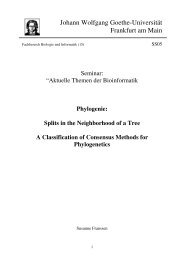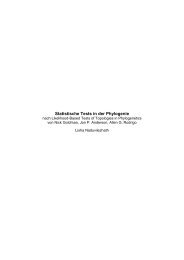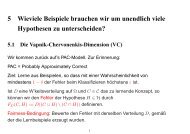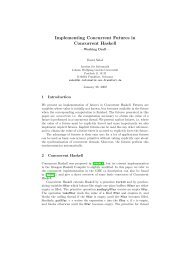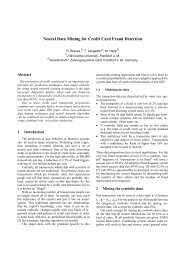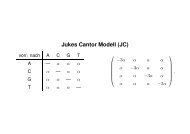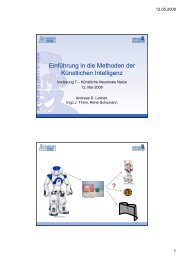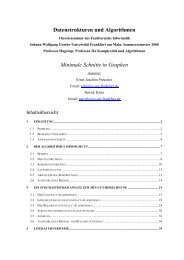Unsupervised Learning of Sequential Patterns
Unsupervised Learning of Sequential Patterns
Unsupervised Learning of Sequential Patterns
Create successful ePaper yourself
Turn your PDF publications into a flip-book with our unique Google optimized e-Paper software.
<strong>Unsupervised</strong> <strong>Learning</strong> <strong>of</strong> <strong>Sequential</strong> <strong>Patterns</strong>Andreas D. Lattner and Otthein HerzogTZI – Center for Computing TechnologiesUniversität Bremen, PO Box 330 440,28334 Bremen, Germany[adl|herzog]@tzi.deAbstractIn order to allow agents for acting autonomously andmaking their decisions on a solid basis an interpretation <strong>of</strong>the current scene has to be done. Scene interpretation canbe done by checking if certain patterns match to the currentbelief <strong>of</strong> the world. In some cases it is impossible to acquireall situations an agent might have to deal with laterat run-time in advance. Here, an automated acquisition <strong>of</strong>patterns would help an agent to adapt to the environment.Agents in dynamic environments have to deal with worldrepresentations that change over time. Additionally, predicatesbetween arbitrary objects can exist in their belief <strong>of</strong>the world. In this work we present a learning approach thatlearns temporal patterns from a sequence <strong>of</strong> predicates.1. IntroductionIn order to allow agents for acting autonomously andmaking their decisions on a solid basis, an interpretation <strong>of</strong>the current scene has to be done. Scene interpretation canbe done by checking if certain patterns match to the currentbelief <strong>of</strong> the world. If intentions <strong>of</strong> other agents or eventsthat are likely to happen in the future can be recognized theagent’s performance can be improved as it can adapt thebehavior to the situation. Example domains are intelligentvehicles or robots in the RoboCup leagues [10, 11].In some cases it is impossible or too time-consuming toacquire all situations an agent might have to deal with atrun-time in advance, or it is necessary that the agent adaptsto a certain situation. It might even not be known what situationsan agent will encounter in the future. In these casesan automated acquisition <strong>of</strong> patterns would help an agent toadapt to the environment.We focus on qualitative representations as they allow fora concise representation <strong>of</strong> the important information. Sucha representation allows to use background knowledge, toplan future actions, to recognize plans <strong>of</strong> other agents, andis comprehensible for humans the same time. In our approachwe map quantitative data to qualitative representations.Time series are divided into different segments whichsatisfy certain monotonicity or threshold conditions as it issuggested by Miene et al. [10, 11]. E.g., if the distancebetween two objects is observed it can be divided into increasingand decreasing distance representing approachingand departing relations (cf. [11]).Agents in dynamic environments have to deal with worldrepresentations that change over time. Additionally, predicatesbetween arbitrary objects can exist in their belief <strong>of</strong>the world. Current learning approaches do not handle theserequirements properly. In this work we present a learningapproach that learns temporal patterns from a sequence <strong>of</strong>predicates.The paper is organized as follows: Section 2 presentswork related to ours. The representation <strong>of</strong> scenes and patternsis described in Sections 3 and 4. Section 5 addressesthe learning <strong>of</strong> patterns. A first evaluation <strong>of</strong> our approach ispresented in Section 6. The paper closes with a conclusionand some ideas for future work.2. Related WorkThere are many approaches in the areas <strong>of</strong> associationrule mining, inductive logic programming, and spatial, temporal,or spatiotemporal data mining which are relevant tothe work presented here. The most important ones are presentedin this section.Association rule mining addresses the problem <strong>of</strong> discoveringassociation rules in data. One famous example isthe mining <strong>of</strong> rules in basket data [1]. Agrawal et al. andZaki et al. present fast algorithms for mining associationrules [2, 14]. These approaches have been developed for themining <strong>of</strong> association rules in item sets. Thus, no temporalrelationships between the items are represented.Mannila et al. extended association rule mining by takingevent sequences into account [8]. They describe al-
gorithms which find all relevant episodes which occur frequentlyin the event sequence.Höppner presents an approach for learning rules abouttemporal relationships between labeled time intervals [5].The labeled time intervals consist <strong>of</strong> propositions. Similarto our work interval relationships are described by Allen’sinterval logic [3]. The major difference is that predicateswhich represent relations between certain objects are notconsidered in their work.Other researchers in the area <strong>of</strong> spatial association rulemining allow for more complex representations with variablesbut do not take temporal interval relations into account(e.g., [6, 7, 9]).The work presented here combines ideas from differentdirections. Similar to Höppner’s work [5] the learned patternsdescribe temporal interrelationships with Allen’s intervallogic. Contrary to Höppner’s approach our representationallows for describing predicates between different objectssimilar to approaches like [7]. The generation <strong>of</strong> frequentpatterns comprises a top-down approach starting fromthe most general pattern and specializing it. At each level <strong>of</strong>the pattern mining just the frequent patterns <strong>of</strong> the previousstep are taken into account knowing that only combinations<strong>of</strong> frequent patterns can result in frequent patterns again.This is a typical approach in association rule mining (e.g.,[8]).Tan et al. present different interestingness measures forassociation patterns [13]. In our work some new evaluationcriteria for the more complex representation are defined.3. Scene RepresentationA dynamic scene is represented by a set <strong>of</strong> objects andpredicates between these objects. The predicates are onlyvalid for certain time intervals and the scene can thus beconsidered as a sequence <strong>of</strong> (spatial or conceptual) predicates.These predicates are in specific temporal relationsregarding the time dimension. Miene et al. presented anapproach how to create such a representation [11].Each predicate r is an instance <strong>of</strong> a predicate definitionrd. We use the letter r for predicates/relations; the letter pis used for patterns. R schema = {rd 1 , rd 2 , . . .} is the set <strong>of</strong>all predicate definitions rd i := 〈l i , a i 〉 with label l i and aritya i , i.e., each rd i defines a predicate between a i objects 1 .Predicates can be hierarchically structured. If a predicatedefinition rd 1 specializes another predicate definition rd 2all instances <strong>of</strong> rd 1 are also instances <strong>of</strong> the super predicaterd 2 .1 It would also be possible to specify more formally what objects areincludinginstance-<strong>of</strong> relations, attributes, etc.; this is omitted here in orderto reduce complexity for the moment. So far we just see objects as uniquelyidentifiable entities.If we have to handle more than one dynamic scene, letS = {s 1 , s 2 , . . .} be the set <strong>of</strong> the different sequences s i . Asingle sequence s i is defined ass i = (R i , T R i , C i )where R i is the set <strong>of</strong> predicates, T R i is the set <strong>of</strong> temporalrelations and C i is the set <strong>of</strong> constants representingdifferent objects in the scene. Each predicate is defined asr(c 1 , . . . , c n ) with r being an instance <strong>of</strong> rd i ∈ R schema ,having arity n = a i , and c i,1 , . . . , c i,n ∈ C i are representingthe objects where the predicate holds. The set<strong>of</strong> temporal relations T R i = {tr 1 , tr 2 , . . .} defines relationsbetween pairs <strong>of</strong> elements in R i . Each temporal relationis defined as tr i (r a , op, r b ) with r a , r b ∈ R i andop ∈ {, d, di, o, oi, m, mi, s, si, f, fi}, i.e., Allen’stemporal relations between intervals [3].Note that it can happen that the same set <strong>of</strong> objects appearsin different instances <strong>of</strong> an identical type <strong>of</strong> predicateat different times. These predicates must be representedby different predicate instances as they usually do not haveidentical temporal interrelations with other predicates, e.g.,two vehicles which are in the relation faster(v1, v2)in two different time intervals i 1 and i 2 . Therefore, we assignIDs r i to the different predicates. An example is:r1 = behind(obj1, obj2)r2 = accelerates(obj1)r3 = leftOf(obj2, obj3)tr1 = r1 o r2tr2 = r1 < r3tr3 = r2 < r3Here, three predicates exist between obj1, obj2, andobj3 (behind, accelerates, and leftOf). Thesepredicates have certain temporal restrictions: r1 must bebefore r3, r2 must be before r3, and r1 overlaps r2.4. Pattern DescriptionThis section introduces the representation <strong>of</strong> patterns,how patterns are to be matched in sequences, and how patternscan be specialized or generalized.4.1. Pattern Representation<strong>Patterns</strong> are abstract descriptions <strong>of</strong> sequence parts withspecific properties. A pattern defines what predicates mustoccur and how their temporal interrelationship has to be.Let P = {p 1 , p 2 , . . .} be the set <strong>of</strong> all patterns p i . A patternis (similar to sequences) defined asp i = (R i , T R i , V i ).R i is the set <strong>of</strong> predicates r ij (v ij,1 , . . . , v ij,n ) withv ij,1 , . . . , v ij,n ∈ V i . V i is the set <strong>of</strong> all variables used in
the pattern. T R i defines the set <strong>of</strong> the temporal relationswhich have already been defined above.An example for such a pattern description is the followingabstraction <strong>of</strong> the sequence above (capital letters standfor variables, lower case letters for constants):r1 = accelerates(X)r2 = behind(X, Y)tr1 = r1 o r2In this pattern there are two predicates and r1 overlapsr2.4.2. Pattern MatchingA pattern p matches in a (part <strong>of</strong> a) sequence sp if thereexists a mapping <strong>of</strong> a subset <strong>of</strong> the constants in sp to allvariables in p such that all predicates defined in the patternexist between the mapped objects and all time constraints<strong>of</strong> p are satisfied by the time intervals in the sequence. Inorder to restrict the exploration region a window size canbe defined. Only matches within a certain neighborhood(specified by the window size) are valid. In our case thewindow size determines the number <strong>of</strong> adjacent start andend time points <strong>of</strong> different predicates which are taken intoaccount for matching a pattern.During the pattern matching algorithm a sliding windowis used, and at each position <strong>of</strong> the window all matches forthe different patterns are collected. A match consists <strong>of</strong> theposition in the sequence and an assignment <strong>of</strong> objects to thevariables <strong>of</strong> the pattern.4.3. Specialization and Generalization <strong>of</strong> <strong>Patterns</strong>Different patterns can be put into generalizationspecializationrelations. A pattern p 1 subsumes another patternp 2 if it covers all sequence parts which are covered byp 2 :p 1 ⊑ p 2 := ∀sp, matches(p 2 , sp) : matches(p 1 , sp).If p 1 additionally covers at least one sequence part whichis not covered by p 2 it is more general:p 1 ⊏ p 2 := p 1 ⊑ p 2 ∧ ∃sp x :matches(p 1 , sp x ), ¬matches(p2, sp x ).This is the case if p 1 ⊑ p 2 ∧ p 1 ⋣ p 2 .In order to specialize a pattern it is possible to add a newpredicate r to R i , add a new temporal relation tr to T R i ,unify two variables, or specialize a predicate, i.e., replacingit with another more special predicate. Accordingly itis possible to generalize a pattern by removing a predicater from R i , removing a temporal relation tr from T R i , insertinga new variable, or generalizing a predicate r, i.e.,replacing it with another more general predicate.Figure 1. Pattern generationAt the specialization <strong>of</strong> a pattern by adding a predicatea new instance <strong>of</strong> any <strong>of</strong> the predicate definitions can beadded to the pattern with variables which are not used inthe pattern so far. If a pattern is specialized by adding anew temporal relation for any pair <strong>of</strong> predicates in the pattern(which has not been constrained so far) a new temporalrestriction can be added. A specialization through variableunification can be done by unifying an arbitrary pair <strong>of</strong> variables.Another specialization would be to replace a predicateby a more special predicate. These different specializationsteps can be used at the top-down induction <strong>of</strong> rules asdescribed in Section 5.1.5. <strong>Unsupervised</strong> <strong>Learning</strong> <strong>of</strong> <strong>Sequential</strong> <strong>Patterns</strong><strong>Unsupervised</strong> learning <strong>of</strong> patterns in a sequence S (or ina set <strong>of</strong> sequences S) is more difficult than learning fromexamples as there is no clear task to separate positive fromnegative examples. The task is to find “interesting” patternswhich appear repeatedly. Unless there is no more informationhow to identify the patterns <strong>of</strong> interest, it just can besearched for patterns that appear frequently in the sequence<strong>of</strong> data.The following subsections present the learning algorithmand evaluation criteria how to estimate the quality <strong>of</strong> a pattern.
5.1. Top-down InductionIn order to create frequent patterns top-down induction isapplied. In the first step all frequent patterns <strong>of</strong> the desiredpattern size (i.e., number <strong>of</strong> used predicates) are created.Here, for all predicates new variables are created. In thesecond step, the patterns are specialized by the unification<strong>of</strong> variables, i.e., the different predicates can be “connected”via identical variables after this step. In the third step temporalrestrictions are added to the patterns. If a maximumvalue for the number <strong>of</strong> patterns to keep (maxP atterns) isset, after each step only the best patterns are kept. The basicsteps are illustrated in Figure 1. The pattern generationalgorithm is:1. Basic pattern generation.(a) Create initial patterns (consisting <strong>of</strong> justone predicate each) and store them in thecurrentP atternsList. Set currentLevel to 1.(b) Remove all patterns from thecurrentP atternsList which do notsatisfy certain conditions (e.g., minimumfrequency). Add all patterns incurrentP atternsList to allP atternsListif currentLevel < minP atternLevel.(c) If currentLevel ≤ maxP atternLevelcreate next level patterns: ClearcurrentP atternsList, specialize all frequentpatterns by combining them with all predicates<strong>of</strong> the frequent patterns <strong>of</strong> the previous stepand store them in the currentP atternsList.Keep the best maxP atterns patterns in theallP atternsList. Go to step 1b.2. Specialize by variable unification.(a) Set the currentP atternList toallP atternList.(b) For each pattern in currentP atternList createall possible variable unifications and store themin the cleared currentP atternList.(c) Remove all patterns from thecurrentP atternsList which do not satisfycertain conditions (e.g., minimum frequency).Add all patterns in currentP atternsList toallP atternsList.(d) If new patterns were created go to step 2b.(e) Keep the best maxP atterns patterns in theallP atternsList.3. Specialize by temporal relations.(a) Set the currentP atternList toallP atternList.(b) For each pattern create statistics about temporalrelations between predicates (i.e., count the occurrences<strong>of</strong> the different interval relations foreach pattern pair).(c) If the creation <strong>of</strong> a temporal relation betweentwo predicates in a pattern does notviolate certain conditions (e.g., minimum frequency),the pattern is copied, specialized bythis temporal relation, and added to the clearedcurrentP atternList.(d) Add all patterns in currentP atternsList toallP atternsList. If new patterns were createdgo to step 3b.(e) Keep the best maxP atterns patterns in theallP atternsList.The parameters <strong>of</strong> the algorithm are:• minPatternLevel: The minimum size <strong>of</strong> the patterns(i.e., the minimum number <strong>of</strong> predicates appearing ineach pattern).• maxPatternLevel: The maximum size <strong>of</strong> the patterns(i.e., the maximum number <strong>of</strong> predicates appearing ineach pattern).• max<strong>Patterns</strong>: The maximum number <strong>of</strong> patterns to bekept after each step <strong>of</strong> the algorithm.5.2. Pattern EvaluationIn order to evaluate the patterns (and to keep the k bestpatterns) an evaluation function was defined. Right now ourevaluation function takes five different values into account:relative pattern size, relative pattern frequency, coherence,temporal restrictiveness, and predicate preference. Furthercriteria can be added if necessary.The relative pattern size is the pattern size divided by themaximum pattern size:relP atSize =patSizemaxP atSizeThis measure prefers larger patterns. The assumption hereis that patterns with more predicates which are still frequentcontain more useful information than shorter ones.The relative pattern frequency is the number <strong>of</strong> matchesmultiplied by the pattern size relative to the length <strong>of</strong> thewhole sequence:relP atF rq =patSize · numMatchessequenceLength
<strong>Patterns</strong> which appear more <strong>of</strong>ten are assigned a highervalue.The coherence gives information how “connected” thepredicates in the pattern are by putting the number <strong>of</strong> usedvariables in relation to the maximum possible number <strong>of</strong>variables for a pattern:coh = 1 −numV ariablesmaxNumberV ariablesHere, the idea is that patterns which are highly connectedthrough variables provide more information because theyare interrelated by shared objects. Currently we just regardbinary predicates, thusmaxNumberV ariables = 2 · patSize.The temporal restrictiveness is the number <strong>of</strong> restrictedpredicate pairs in the pattern to the maximum number <strong>of</strong>time restrictions:tmpRestr ==numRestrictedP redP airsmaxNumRestrictedP redP airsnumRestrictedP redP airspatSize·(patSize−1)2Again it is assumed to be advantageous if the pattern is morespecialized. A higher number <strong>of</strong> temporal restrictions leadsto a higher value.Predicate preference computes the mean <strong>of</strong> all used predicatepreferences:prP ref =patSize1 ∑preference(predicate i )patSizei=1This is needed if certain predicates should be privileged,e.g., if some predicates are assumed to be more useful thanothers.The overall evaluation function <strong>of</strong> a pattern computes aweighted sum <strong>of</strong> the five values:eval =a · relP atSize + b · relP atF rq + c · coh + d · tmpRestr + e · prP refa + b + c + d + eAll single measures and the overall pattern quality havevalues between 0 and 1.6. EvaluationThis section presents a first evaluation <strong>of</strong> our learning algorithm.First, the idea is shown by applying the algorithmto a simple example. After that experiments on some morecomplex data with varying parameters are presented. Finally,some statements about the complexity <strong>of</strong> the currentalgorithm are given.s; behind; a; bs; faster; x; ye; behind; a; bs; leftOf; a; be; leftOf; a; be; faster; x; ys; behind; b; ae; behind; b; as; behind; a; cs; approaches; x; ye; behind; a; cs; leftOf; a; ce; leftOf; a; ce; approaches; x; ys; behind; c; ae; behind; c; as; behind; a; ds; follows; x; ye; behind; a; ds; leftOf; a; de; leftOf; a; de; follows; x; ys; behind; d; ae; behind; d; as; faster; x; ze; faster; x; zFigure 2. Input for sequence exampleStep New patterns Kept patterns All patternsInitial patterns 5 5 0Pattern level 2 15 10 10Pattern level 3 28 13 23Unification 1 255 57 80Unification 2 393 51 131Unification 3 200 15 146Unification 4 32 1 147Unification 5 1 0 147Temp. Rest. 1 13 13 160Temp. Rest. 2 21 21 181Temp. Rest. 3 9 9 190Table 1. Number <strong>of</strong> patterns in the differentsteps <strong>of</strong> the algorithm6.1. Simple ExampleIn this subsection patterns for a simple artificial exampleare created. In the example there are seven different objects(a - d and x - z), five predicates (behind, faster,leftOf, approaches, and follows). The input datais shown in Figure 2. The first column gives the informationif the interval starts or ends in this row. The names <strong>of</strong> thepredicates are in the second column. The third and fourthcolumns show the IDs <strong>of</strong> the objects for which the predicateholds. The temporal order is represented by the rows fromtop to bottom.Figure 3 shows the different intervals in this example. Asit can be seen, object a has behind and leftOf relationsto the objects b, c, and d. The predicates with x, y, and zare not important; they are just “noise” in the example.The program was started with these parameters:• minP atternSize = 2,• maxP atternSize = 3, and• maxP atterns = ∞ (i.e., keep all created patterns).The weights <strong>of</strong> the evaluation function were set to: a =0.2, b = 0.4, c = 0.2, d = 0.2, and e = 0.0. The predicatepreference has not been realized so far and is thus not takeninto account here.Table 1 shows the number <strong>of</strong> patterns for the differentsteps. Note that patterns are just kept if they have more than
Figure 3. Example sequence and matched patternPatternbehind(X 9 X 29)[r 1], leftOf(X 9 X 29)[r 2], behind(X 29X 9)[r 3], r 1r 2: before, r 1r 3: before, r 2r 3:beforebehind(X 9 X 29)[r 1], leftOf(X 9 X 29)[r 2], behind(X 29X 9)[r 3], r 1r 2: before, r 1r 3: beforebehind(X 9 X 29)[r 1], leftOf(X 9 X 29)[r 2], behind(X 29X 9)[r 3], r 1r 3: before, r 2r 3: beforebehind(X 9 X 29)[r 1], leftOf(X 9 X 29)[r 2], behind(X 29X 9)[r 3], r 1r 2: before, r 2r 3: beforebehind(X 9 X 29)[r 1], leftOf(X 9 X 29)[r 2], behind(X 29X 9)[r 3], r 2r 3: beforeTable 2. Five best patternsOverallquality0.7800.7130.7130.7130.646one predicate. The five best patterns are shown in Table 2.The intended pattern in the example was a simplified overtakingscenario (first, the overtaking car is behind anothercar, then it is left <strong>of</strong>, and finally the objects in the behindpredicate are switched). As it can be seen, the intended patternwas found and evaluated best. Matched sequence partsare illustrated in Figure 3, enclosed by a dashed line.6.2. ExperimentsWe evaluated the algorithm on an artificial data set withdifferent settings. In order to create random data sets wewrote a program which generates input data for our learningprogram. Different parameters allow for creating differenttest sets. The parameters are: number <strong>of</strong> predicates,number <strong>of</strong> constants, fraction <strong>of</strong> “real patterns” in the randomdata, and the length <strong>of</strong> the sequence. As the “realpattern” the one above (behind(X, Y), leftOf(X,Y), behind(Y, X)) was used with varying constantsfor X and Y and some random predicates inside the pattern.For the experiments random sequences with 500 predicates(i.e., 1000 start and end time points) were created. Theevaluation function was the same as shown above in Section6.1. The window size was set to 15 (large enough to find theintended pattern). The number <strong>of</strong> constants (representingobjects) was five in all settings. The minimum frequency inorder to keep a pattern was 0.1. Figure 4 shows the number<strong>of</strong> created and kept patterns for the different settings in theexperiments.The number <strong>of</strong> predicates was varied in the first experiment(5, 7, 9, and 11). One interesting fact is that with anincreasing number <strong>of</strong> predicates the number <strong>of</strong> created patternsdecreases. This seems counterintuitive at first glance.This phenomenon can be explained by the randomly createddata. The more predicates are used the less frequent patternswith (random) predicates are created. This explains the decreasingnumber <strong>of</strong> created patterns in the first experiment.In the second experiment the maximum size <strong>of</strong> the patternswas set to different values (2 - 5). This experimentshows the problem <strong>of</strong> complexity. With the increasing maximalsize <strong>of</strong> patterns the number <strong>of</strong> created patterns growsexponentially. Future modifications <strong>of</strong> the algorithm shouldaddress this problem.In the third experiment the number <strong>of</strong> patterns to keep aftereach step <strong>of</strong> the algorithm was varied (maxP atterns =5, 10, 15, 20). It shows how the number <strong>of</strong> created (andkept) patterns can be reduced by just keeping a certain number<strong>of</strong> patterns after each step <strong>of</strong> the basic pattern generation.The number <strong>of</strong> kept patterns almost stays constant.This might be due to the fact that many <strong>of</strong> the bad performingpatterns are not created as their “parents” are prunedearly while the important patterns are kept after each step.6.3. ComplexityThe algorithm consists <strong>of</strong> three main steps. The basicpattern generation algorithm creates predicate combinationsup to an upper bound (the pattern size). If all predicatecombinations were created the number <strong>of</strong> created patternswould be equal to the number <strong>of</strong> possibilities to take k elementsout <strong>of</strong> n elements ignoring the order and allowingto draw elements repeatedly. Let n be the number <strong>of</strong> predicatesand k the maximum pattern size. Then the number <strong>of</strong>basic patterns to be created is:( ) n + k − 1#basicP atterns =kTable 3 shows the number <strong>of</strong> possible patterns for differentpattern sizes if five predicates exist, i.e., n = 5.The variable unification problem is similar to the problem<strong>of</strong> creating all possible clusters <strong>of</strong> arbitrary sizes for nobjects. This leads to the Bell number [4]. The number
Varying number <strong>of</strong> predicatesSize <strong>of</strong> pattern 1 2 3 4 5#possibleRestrictions 1 14 14 3 14 6 14 10#patterns#patterns#patterns0 500 1000 15000 10000 30000 500000 500 1000Generated patternsKept patterns5 6 7 8 9 10 11Generated patternsKept patterns#predicatesVarying pattern size2.0 2.5 3.0 3.5 4.0 4.5 5.0Generated patternsKept patternsPattern sizeVarying number <strong>of</strong> kept patterns5 10 15 20max<strong>Patterns</strong>Figure 4. Evaluation resultsSize <strong>of</strong> pattern 1 2 3 4 5#possible<strong>Patterns</strong> 5 15 35 70 126Table 3. Number <strong>of</strong> possible patterns with fivepredicates<strong>of</strong> all possible variable combinations for n variables can becomputed by the formula (cf. [12]):n∑{ n#posV arUnific =k}=k=1n∑k=11k!k∑( ) k(−1) k−j j njj=1The Bell numbers for different n are shown in Table 4.The number <strong>of</strong> possible temporal restrictions for a patterndepends on the number <strong>of</strong> predicates used in the patternn 1 2 3 4 5 6 7 8 9 10B n 1 2 5 15 52 203 877 4140 21147 115975Table 4. Bell numbersTable 5. Number <strong>of</strong> possible temporal restrictionswith five predicatesand the number <strong>of</strong> temporal relations. It is possible to assignone <strong>of</strong> Allen’s 13 relations or no relation to each predicatepair. Of course, not all combinations are possible (e.g., ifp1 is before p2 and p2 is before p3 there p1 must be beforep3). For simplicity, we assume independency betweenthe predicate pairs for the moment. In that case for eachpredicate pair 14 variations are possible. Thus, we have tocalculate the power <strong>of</strong> 14 to the number <strong>of</strong> possible predicatepairs (n is the number <strong>of</strong> predicates in the pattern):numP redP airs#temporalRestrictions = 14= 14 n·(n−1)2Table 5 shows the number <strong>of</strong> temporal restrictions for differentpattern sizes if five predicates are used.Altogether the number <strong>of</strong> possible patterns grows veryhigh if the number <strong>of</strong> used predicates in patterns is large.First <strong>of</strong> all, many “basic patterns” are created in this case.For each <strong>of</strong> these patterns many variable unifications arepossible (depending on the number <strong>of</strong> variables in all predicates<strong>of</strong> the pattern). In the last step for each <strong>of</strong> the unifiedpatterns many variations <strong>of</strong> temporal restrictions are possible.This shows that a modification <strong>of</strong> the algorithm hasto be done in order to make it applicable to more complexsituations.7. Conclusion and Future WorkThe approach presented here allows for learning patternsfrom sequential symbolic data. As the representation consists<strong>of</strong> predicates which describe relations between differentobjects more complex patterns can be learned comparedto propositional event sequences. The unsupervised patternlearning algorithm performs a top-down search from themost general to more specific patterns. In the first step frequentbasic patterns are generated (similar to standard associationrule mining). In the second step variable unificationleads to an interconnection <strong>of</strong> predicates and thus to morecoherent patterns. In the third step the patterns are specializedby temporal constraints. Here, Allen’s interval logicis used to interrelate the predicates in the patterns temporarily.An evaluation function was introduced, which takes intoaccount the special properties <strong>of</strong> our pattern representation.The algorithm was implemented and tested on artificial datasets.Although the basic algorithm has been implemented alreadythere are many possibilities for future work. Even
though the incremental generation <strong>of</strong> new patterns just fromfrequent patterns excludes many unimportant patterns, thecomplexity <strong>of</strong> the algorithm is still very high. An interestingresearch direction is to find out which heuristics couldreduce complexity and still lead to good patterns. Anotherpossibility is to prevent the program from the generation <strong>of</strong>certain patterns by leaving out (temporal) relations whichare not possible due to some constraints. These constraintscould be identified e.g., by accessing a composition table asintroduced by Allen [3] as it was done by Höppner [5]. Insome cases it might be also possible to reduce the number<strong>of</strong> temporal relations. If some <strong>of</strong> the 13 relations are notneeded (or do not appear in the data) they can be omitted inorder to reduce complexity.The creation <strong>of</strong> temporal restrictions is quite straightforwardso far as just one temporal relation is allowed betweentwo predicates. If the semantic is changed to “allowed temporalrelations”, more than one temporal relation could beallowed for each predicate pair. This would lead to a morepowerful representation <strong>of</strong> the temporal restrictiveness.In the current version <strong>of</strong> the algorithm just frequent patternsare generated. In future versions it would interestingto create (temporal) association rules, which can be appliedfor anticipating (possible) future events.In future work the pattern learning has to be evaluated insome application context with real data in order to evaluatehow beneficial such learned patterns can be. This can bedone in the context <strong>of</strong> intelligent agents which should uselearned patterns to improve their future behavior, e.g., byavoiding unfavorable or dangerous situations or by reusingpartial plans which have been computed in similar situationbefore to save time.8. AcknowledgementsThe content <strong>of</strong> this paper is a partial result <strong>of</strong> the ASKOFproject which is funded by the Deutsche Forschungsgemeinschaft(DFG, German Research Foundation) undergrant HE989/6-1. We would like to thank Björn Gottfried,Martin Lorenz, Ingo J. Timm, and Tom Wetjen for interestingdiscussions on the learning <strong>of</strong> patterns and complexitycalculations, and for their comments how to improve thispaper.ference on Very Large Data Bases, VLDB, pages 487–499,September 1994.[3] J. F. Allen. Maintaining knowledge about temporal intervals.Communications <strong>of</strong> the ACM, 26(11):832–843, November1983.[4] E. T. Bell. Exponential numbers. The American MathematicalMonthly, 41(7):411 – 419, August/September 1934.[5] F. Höppner. <strong>Learning</strong> temporal rules from state sequences.In Proceedings <strong>of</strong> the IJCAI’01 Workshop on <strong>Learning</strong> fromTemporal and Spatial Data, pages 25–31, Seattle, USA,2001.[6] K. Koperski and J. Han. Discovery <strong>of</strong> spatial associationrules in geographic information databases. In Proceedings<strong>of</strong> the 4th International Symposium on Advances in SpatialDatabases, SSD, pages 47–66, Portland, Maine, 1995.[7] D. Malerba and F. A. Lisi. An ILP method for spatial associationrule mining. In Working notes <strong>of</strong> the First Workshop onMulti-Relational Data Mining, pages 18–29, Freiburg, Germany,2001.[8] H. Mannila, H. Toivonen, and A. I. Verkamo. Discovery<strong>of</strong> frequent episodes in event sequences. Data Mining andKnowledge Discovery, 1:259–289, 1997.[9] J. Mennis and J. W. Liu. Mining association rules in spatiotemporaldata. In Proceedings <strong>of</strong> the 7th International Conferenceon GeoComputation, University <strong>of</strong> Southampton,UK, 8 - 10 September 2003.[10] A. Miene, A. D. Lattner, U. Visser, and O. Herzog.Dynamic-preserving qualitative motion description for intelligentvehicles. In Proceedings <strong>of</strong> the IEEE IntelligentVehicles Symposium (IV ’04), pages 642–646, June 14-172004.[11] A. Miene, U. Visser, and O. Herzog. Recognition and prediction<strong>of</strong> motion situations based on a qualitative motiondescription. In D. Polani, B. Browning, A. Bonarini, andK. Yoshida, editors, RoboCup 2003 – Proceedings <strong>of</strong> theInternational Symposium, July 10.-11., 2003, Padua, Italy,2003.[12] J. Pitman. Some probabilistic aspects <strong>of</strong> set partitions. TheAmerican Mathematical Monthly, 104(3):201–209, March1997.[13] P.-N. Tan, V. Kumar, and J. Srivastava. Selecting the right interestingnessmeasure for association patterns. In Proceedings<strong>of</strong> the Eight International Conference on KnowledgeDiscovery and Data Mining (KDD’02), pages 32–41, 2002.[14] M. J. Zaki, S. Parthasarathy, M. Ogihara, and W. Li. Newalgorithms for fast discovery <strong>of</strong> association rules. In Proceedings<strong>of</strong> the 3rd International Conference on KnowledgeDiscovery and Data Mining, pages 283–296, 1997.References[1] R. Agrawal, T. Imielinski, and A. N. Swami. Mining associationrules between sets <strong>of</strong> items in large databases. InProceedings <strong>of</strong> the 1993 ACM SIGMOD International Conferenceon Management <strong>of</strong> Data, pages 207–216, Washington,D.C., May 1993.[2] R. Agrawal and R. Srikant. Fast algorithms for mining associationrules. In Proceedings <strong>of</strong> the 20th International Con-



